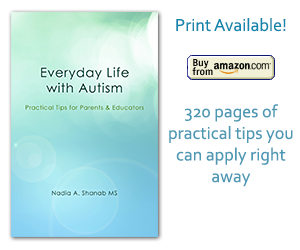By Nadia Shanab | Uncategorized
Dear Parents, Here comes another school year along with lots of hopes and loads of goals for your child’s future! Over the summer break you have probably set some goals for your child and pictured her in a certain setting that would rather satisfy your dreams. Good job! This exactly what parents are here for.
Tags: autism, communication, discipline, flexibility, health, independence, mainstreaming, occupational therapy, parenting, schedule, sensory, social interaction, tips, transition
Posted in Uncategorized | Comments Off on Mainstreaming Children with Autism
By Nadia Shanab | Uncategorized
One of the most important traits of autism is the poor or even lack of communication. How does communication capability develop? In the early childhood years a typical child would integrate the “seen” and “heard” information to develop her speech. Consequently, the child would be able to talk and communicate. It appears that children with
Tags: asperger's syndrome, autism, communication, health, parenting, research, sensory, sensory integration issues, social interaction, speech
Posted in Uncategorized | Comments Off on Communication Improves over Time
By Nadia Shanab | Uncategorized
The Autism File U.S.A is a free digital magazine offering resources, information and support. You can download it here. The Autism File magazine is a bi-monthly publication. Its first issue appeared in 1999. Enjoy! nadia shanab
Tags: asperger's syndrome, autism, health, parenting, research, social interaction, symptoms of autism, techniques
Posted in Uncategorized | Comments Off on A Free Autism Magazine
By Nadia Shanab | Uncategorized
It is an ongoing debate whether iPads and touch devices in general are benefitial or harmful for kids with autism. From my own experience working with children on the autism spectrum, whether with poor verbal skills or high-functioning, they all love the iPad. It is a magical device that we in schools now use it
Tags: ADHD, asperger's syndrome, autism, communication, discipline, flexibility, iPad, occupational therapy, parenting, sensory, social interaction, speech, tips, visual aids
Posted in Uncategorized | Comments Off on iPads May Help Kids with Autism
By Nadia Shanab | Uncategorized
As I mentioned in the previous post, schools are going to welcome their precious students very soon. Parents, please read the fact sheet and make sure to share it with your child’s teacher(s). Co-operation between home and school is major key to your child’s success. Communication facilitates the mission of raising and educating our children.
Tags: asperger's syndrome, autism, communication, fact sheet, flexibility, health, independence, occupational therapy, organization, parenting, placement, schedule, sensory, social interaction, speech, symptoms of autism, tips, visual aids
Posted in Uncategorized | Comments Off on Important Fact Sheet
By Nadia Shanab | Uncategorized
A new school year is around the corner and about to emerge! Parents and educators are you ready? Here are some tips to help you get off on the right foot. Bear in mind, there are three main goals in raising and educating children with autism that we are working on: Independence Better Social Skills Stronger Communication
Tags: autism, back-to-school, communication, discipline, early intervention, flexibility, health, independence, organization, parenting, placement, research, schedule, sensory, social interaction, tips, visual aids
Posted in Uncategorized | Comments Off on Parents & Educators, Are You Ready for A New School Year?
By Nadia Shanab | Uncategorized
Keeping your child engaged in doing useful activities is vital for her developmental growth. Wasting time watching TV for hours or playing video games all day long is not the best investment of summer time. Here are some ideas for activities to spend time on: Enroll your child in an art & crafts class. Enroll
Tags: autism, communication, discipline, flexibility, health, independence, parenting, sensory, social interaction, Temple Grandin
Posted in Uncategorized | Comments Off on Things To Do During The Summer
By Nadia Shanab | Uncategorized
Morgan Autism Center Announces 12th Annual Autism Conference: “Transitions: Bridges to Success” Saturday, September 28, 2013 7:00 am – 5:00 pm Mayer Theatre, Santa Clara University 500 El Camino Real Santa Clara, CA … SCHEDULED SPEAKERS: Jed Baker Director of The Social Skills Training Project Jill Escher, Parent & Autism Activist What Causes Autism? How
Tags: asperger's syndrome, autism, communication, conference, discipline, health, independence, occupational therapy, parenting, rewards, schedule, senses, social interaction, speech, symptoms of autism, techniques, transition, visual aids
Posted in Uncategorized | Comments Off on 12th Annual Morgan Autism Conference 2013
By Nadia Shanab | Uncategorized
Although some children with autism exhibit poor attention skills, a research suggests that autism cannot be blamed for. The main three autism traits are: Poor social skills Poor communication skills Limited areas of interest The cause of holding these signs accountable for autism has not been found yet. The study suggests to take the following
Tags: ADHD, autism, communication, parenting, research, social interaction, symptoms of autism
Posted in Uncategorized | 2 Comments »
By Nadia Shanab | Uncategorized
Asperger’s Syndrome used to be classified as a distinct disorder different from the ASD (Autism Spectrum Disorder). The new (DSM-5) Diagnostic and Statistical Manual of Mental Disorder has simply included the Asperger’s Syndrome within the ASD. By doing this the disorder loses its diagnosis and becomes part of the autism spectrum. A compromise would be
Tags: asperger's syndrome, autism, DSM-5, health, parenting, research, sensory, social interaction, symptoms of autism
Posted in Uncategorized | Comments Off on A Dilemma: Where Does Asperger’s Syndrome Belong?

